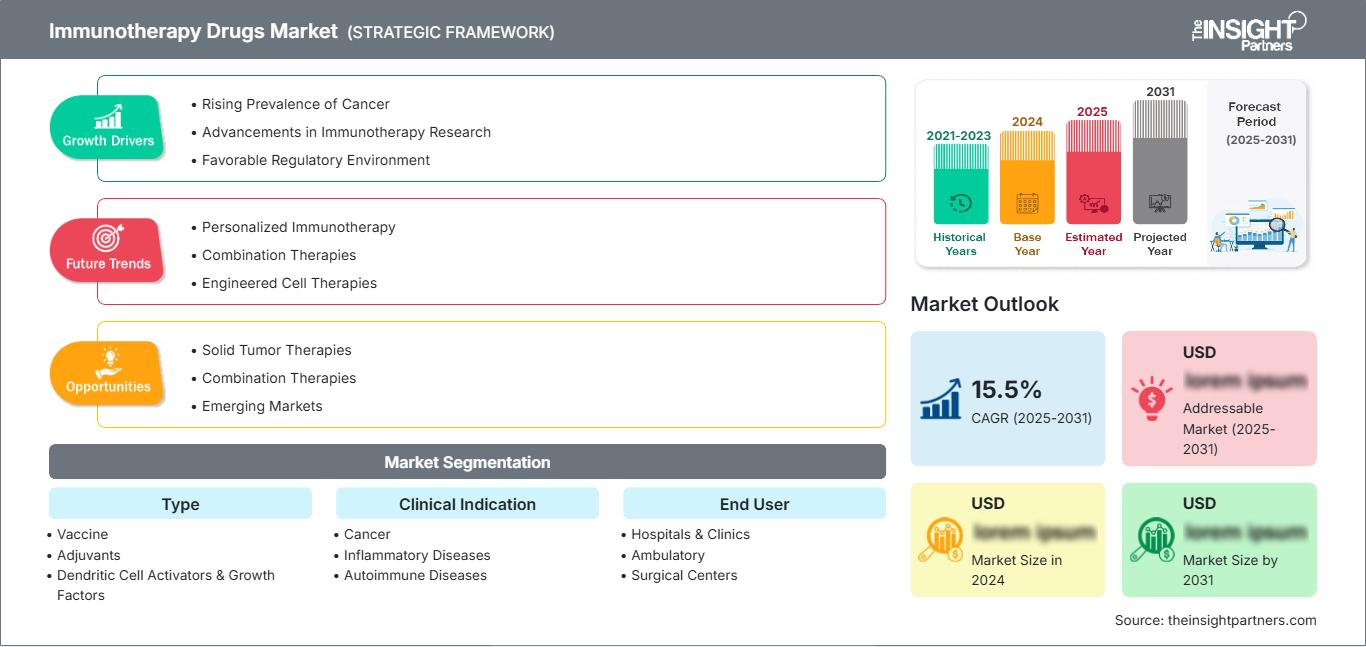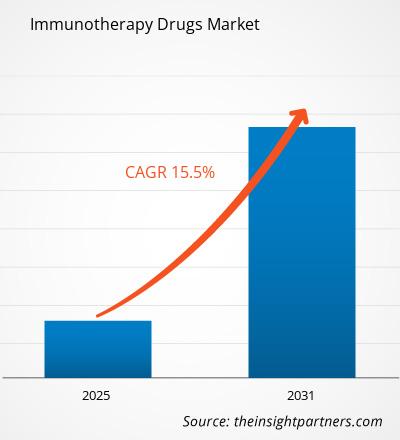Der Markt für Immuntherapeutika wird bis 2031 voraussichtlich ein Volumen von 391,81 Milliarden US-Dollar erreichen. Für den Zeitraum 2025–2031 wird ein jährliches Wachstum von 10,2 % erwartet.
Der Bericht ist nach Wirkstofftyp (Impfstoffe, Adjuvantien, Aktivatoren und Wachstumsfaktoren dendritischer Zellen, Stimulatoren und Wachstumsfaktoren von T-Zellen, Immun-Checkpoint-Inhibitoren, monoklonale Antikörper, Interleukine und Interferone, Sonstige) und klinischer Indikation (Krebs, Entzündungskrankheiten, Autoimmunerkrankungen, Infektionskrankheiten, Sonstige) segmentiert. Die globale Analyse wird zudem auf regionaler Ebene und für wichtige Länder aufgeschlüsselt. Der Bericht „Immuntherapeutika-Markt“ von The Insight Partners beschreibt die aktuelle Marktlage, das zukünftige Wachstum, die wichtigsten Wachstumstreiber, Herausforderungen und Chancen. Dies wird verschiedenen Akteuren im Geschäftsbereich Einblicke ermöglichen, wie beispielsweise:
- Technologieanbieter/Hersteller: Um die sich entwickelnde Marktdynamik zu verstehen und potenzielle Wachstumschancen zu erkennen, können sie fundierte strategische Entscheidungen treffen.
- Investoren: Um eine umfassende Trendanalyse hinsichtlich Marktwachstumsrate, Finanzprognosen und Chancen entlang der Wertschöpfungskette durchzuführen.
- Regulierungsbehörden: Um Richtlinien zu regulieren und Aktivitäten auf dem Markt zu überwachen, mit dem Ziel, Missbrauch zu minimieren, das Vertrauen der Anleger zu wahren und die Integrität und Stabilität des Marktes zu gewährleisten. Marktsegmentierung für Immuntherapeutika: Typ
- Impfstoffe
- Adjuvantien
- Aktivatoren und Wachstumsfaktoren für dendritische Zellen
- T-Zell-Stimulatoren und Wachstumsfaktoren
- Immun-Checkpoint-Inhibitoren
- Monoklonale Antikörper
- Interleukine und Interferone
- Sonstige
Klinische Indikation
- Krebs
- Entzündliche Erkrankungen
- Autoimmunerkrankungen
- Infektionskrankheiten
- Sonstige
Endnutzer
- Krankenhäuser und Kliniken
- Ambulante Einrichtungen
- Chirurgische Zentren
- Sonstige
Geografie
- Nordamerika
- Europa
- Asien-Pazifik
- Süd- und Mittelamerika
- Naher Osten und Afrika
Passen Sie diesen Bericht Ihren Anforderungen anSie erhalten kostenlos Anpassungen an jedem Bericht, einschließlich Teilen dieses Berichts oder einer Analyse auf Länderebene, eines Excel-Datenpakets sowie tolle Angebote und Rabatte für Start-ups und Universitäten.
Markt für Immuntherapie-Medikamente: Strategische Einblicke

-
Holen Sie sich die wichtigsten Markttrends aus diesem Bericht.Dieses KOSTENLOSE Beispiel umfasst Datenanalysen, die von Markttrends bis hin zu Schätzungen und Prognosen reichen.
Wachstumstreiber des Marktes für Immuntherapeutika
- Zunehmende Krebsprävalenz: Die steigende Inzidenz verschiedener Krebsarten, insbesondere immunbedingter Krebserkrankungen, treibt die Nachfrage nach Immuntherapeutika an.
- Fortschritte in der Immuntherapieforschung: Laufende Forschung und Entwicklung im Bereich der Immuntherapie führen zur Entdeckung neuartiger Therapien und Behandlungskombinationen.
- Günstiges regulatorisches Umfeld: Unterstützende regulatorische Rahmenbedingungen und beschleunigte Zulassungsverfahren beschleunigen die Entwicklung und Vermarktung von Immuntherapeutika.
Zukünftige Trends des Marktes für Immuntherapeutika
- Personalisierte Immuntherapie: Anpassung der Immuntherapie an die individuellen Patienten auf Grundlage ihrer genetischen Ausstattung und der Tumoreigenschaften.
- Kombinationstherapien: Kombination der Immuntherapie mit anderen Behandlungen wie Chemotherapie und Strahlentherapie zur Steigerung der Wirksamkeit und Reduzierung von Nebenwirkungen.
- Gentechnisch veränderte Zelltherapien: Entwicklung gentechnisch veränderter Zelltherapien, wie z. B. der CAR-T-Zelltherapie, zur gezielten Behandlung spezifischer Krebszellen.
Marktchancen für Immuntherapeutika
- Therapien solider Tumore: Erweiterung des Anwendungsbereichs der Immuntherapie zur Behandlung solider Tumore, wie z. B. Lungen-, Brust- und Darmkrebs.
- Kombinationstherapien: Entwicklung innovativer Kombinationstherapien zur Verbesserung der Patientenergebnisse und zur Überwindung von Therapieresistenzen.
- Wachstumsmärkte: Erschließung von Wachstumsmärkten mit steigendem Bedarf im Gesundheitswesen und zunehmender Nachfrage nach fortschrittlichen Krebstherapien.
Markt für Immuntherapeutika
Die regionalen Trends und Einflussfaktoren auf den Markt für Immuntherapeutika im gesamten Prognosezeitraum wurden von den Analysten von The Insight Partners ausführlich erläutert. Dieser Abschnitt behandelt außerdem die Marktsegmente und die geografische Verteilung des Marktes für die Behandlung von Herzrhythmusstörungen in Nordamerika, Europa, dem asiatisch-pazifischen Raum, dem Nahen Osten und Afrika sowie Süd- und Mittelamerika.
Umfang des Marktberichts zu Immuntherapie-Medikamenten
By Klinische Indikation- Krebs
- entzündliche Erkrankungen
- Autoimmunerkrankungen
- Infektionskrankheiten
- Sonstige
- Krankenhäuser und Kliniken
- Ambulanzen
- chirurgische Zentren
- Sonstige
- Nordamerika
- Europa
- Asien-Pazifik
- Süd- und Mittelamerika
- Naher Osten und Afrika
- Großbritannien
- Deutschland
- Frankreich
- Russland
- Italien
- Restliches Europa
- China
- Indien
- Japan
- Australien
- Restlicher Asien-Pazifik
- Brasilien
- Argentinien
- Restliches Süd- und Mittelamerika
- Südafrika
- Saudi-Arabien
- Vereinigte Arabische Emirate
- Restlicher Naher Osten und Afrika
Berichtsattribut Einzelheiten Marktgröße in 2024 US$ XX Billion Marktgröße nach 2031 US$ 391.81 Billion Globale CAGR (2025 - 2031) 10.2% Historische Daten 2021-2023 Prognosezeitraum 2025-2031 Abgedeckte Segmente By Typ - Impfstoff
- Adjuvantien
- dendritische Zellaktivatoren und Wachstumsfaktoren
- T-Zellstimulatoren und Wachstumsfaktoren
- Immun-Checkpoint-Inhibitoren
- monoklonale Antikörper
- Interleukine und Interferone
- andere
Abgedeckte Regionen und Länder Nordamerika - USA
- Kanada
- Mexiko
Marktführer und wichtige Unternehmensprofile - Eli Lilly and Company
- Astrazeneca
- Abbvie
- Amgen inc
- GlaxoSmithKline Plc
- Novartis International AG
- Merck and Co., Inc
- F. Hoffmann-La Roche AG
- Bristol-Myers Squibb
Dichte der Marktteilnehmer im Bereich Immuntherapie-Medikamente: Auswirkungen auf die Geschäftsdynamik
Der Markt für Immuntherapeutika wächst rasant, angetrieben durch die steigende Nachfrage der Endverbraucher. Gründe hierfür sind unter anderem sich wandelnde Verbraucherpräferenzen, technologische Fortschritte und ein wachsendes Bewusstsein für die Vorteile der Produkte. Mit steigender Nachfrage erweitern Unternehmen ihr Angebot, entwickeln innovative Lösungen, um den Bedürfnissen der Verbraucher gerecht zu werden, und nutzen neue Trends, was das Marktwachstum weiter ankurbelt.

- Holen Sie sich die Markt für Immuntherapie-Medikamente Übersicht der wichtigsten Akteure
Wichtigste Verkaufsargumente
- Umfassende Abdeckung: Der Bericht bietet eine umfassende Analyse der Produkte, Dienstleistungen, Typen und Endnutzer des Marktes für Immuntherapeutika und vermittelt so ein ganzheitliches Bild.
- Expertenanalyse: Der Bericht basiert auf dem fundierten Wissen von Branchenexperten und Analysten.
- Aktuelle Informationen: Der Bericht gewährleistet Geschäftsrelevanz durch die Berücksichtigung aktueller Informationen und Datentrends.
- Anpassungsmöglichkeiten: Dieser Bericht kann an spezifische Kundenanforderungen angepasst werden und sich optimal in die Geschäftsstrategien integrieren.
Der Forschungsbericht zum Markt für Immuntherapeutika kann somit maßgeblich dazu beitragen, das Branchenszenario und die Wachstumsaussichten zu entschlüsseln und zu verstehen. Auch wenn einige berechtigte Bedenken bestehen, überwiegen die Vorteile dieses Berichts insgesamt die Nachteile.
- Historische Analyse (2 Jahre), Basisjahr, Prognose (7 Jahre) mit CAGR
- PEST- und SWOT-Analyse
- Marktgröße Wert/Volumen – Global, Regional, Land
- Branchen- und Wettbewerbslandschaft
- Excel-Datensatz
Aktuelle Berichte
Verwandte Berichte
Erfahrungsberichte
Grund zum Kauf
- Fundierte Entscheidungsfindung
- Marktdynamik verstehen
- Wettbewerbsanalyse
- Kundeneinblicke
- Marktprognosen
- Risikominimierung
- Strategische Planung
- Investitionsbegründung
- Identifizierung neuer Märkte
- Verbesserung von Marketingstrategien
- Steigerung der Betriebseffizienz
- Anpassung an regulatorische Trends






















 Kostenlose Probe anfordern für - Markt für Immuntherapie-Medikamente
Kostenlose Probe anfordern für - Markt für Immuntherapie-Medikamente